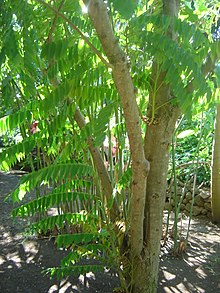Averrhoa bilimbi
| Averrhoa bilimbi | |
|---|---|
 |
|
| Scientific classification | |
| Kingdom: | Plantae |
| (unranked): | Angiosperms |
| (unranked): | Eudicots |
| (unranked): | Rosids |
| Order: | Oxalidales |
| Family: | Oxalidaceae |
| Genus: | Averrhoa |
| Species: | A. bilimbi |
| Binomial name | |
|
Averrhoa bilimbi L. |
|
| Synonyms | |
|
|
Averrhoa bilimbi (commonly known as bilimbi, cucumber tree, or tree sorrel) is a fruit-bearing tree of the genus Averrhoa, family Oxalidaceae. It is a close relative of carambola tree.
The bilimbi tree reaches 5–10 m in height. Its trunk is short and quickly divides up into ramifications. Bilimbi leaves, 3–6 cm long, are alternate, imparipinnate and cluster at branch extremities. There are around 11 to 37 alternate or subopposite oblong leaflets. The leaves are quite similar to those of the Otaheite gooseberry. The trunk and branches of tree has to be exposed to sunlight for fruits to form (traditional knowledge), which is achieved by removing leaves except from branch end.
Possibly originated in Moluccas, Indonesia, the species is now cultivated and found throughout the Philippines, Indonesia, Sri Lanka, Bangladesh, Maldives, Myanmar (Burma) and Malaysia. It is also common in other Southeast Asian countries. In India, where it is usually found in gardens, the bilimbi has gone wild in the warmest regions of the country.
Outside of Asia, the tree is cultivated in Zanzibar. In 1793, the bilimbi was introduced to Jamaica from Timor and after several years, was cultivated throughout Central and South America where it is known as mimbro. In Suriname this fruit is known as lange birambi. Introduced to Queensland at the end of the 19th century, it has been grown commercially in the region since that time.
...
Wikipedia
